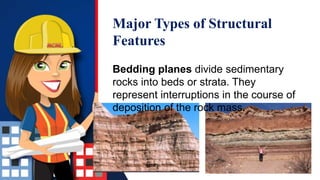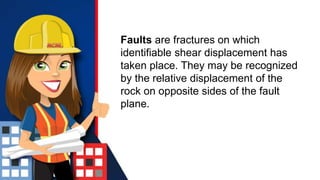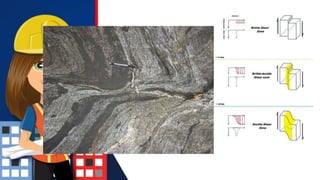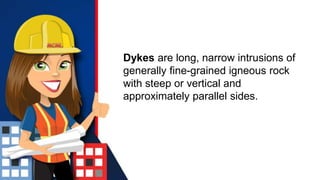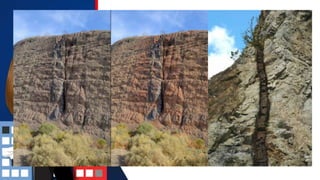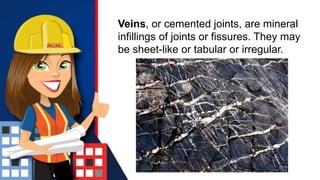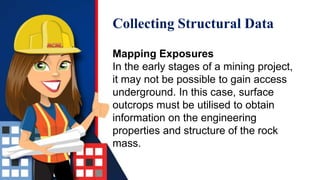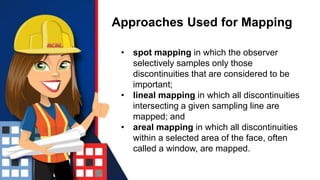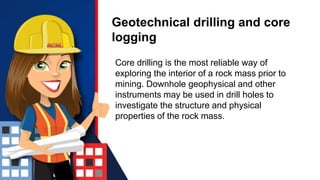Rock_p4_Rock Mass Characterization.pptx
- 1. Rock Mass Structure and Characterization BY: MARIA CARISSA M. LANDOY, RCE
- 2. Rock material is the term used to describe the intact rock between discontinuities; it might be represented by a hand specimen or piece of drill core examined in the laboratory.
- 3. Rock mass is the total in situ medium containing bedding planes, faults, joints, folds and other structural features.
- 4. The nature and distribution of structural features within the rock mass is known as the rock structure.
- 5. Major Types of Structural Features Bedding planes divide sedimentary rocks into beds or strata. They represent interruptions in the course of deposition of the rock mass.
- 6. Folds are structures in which the attitudes of the beds are changed by flexure resulting from the application of post-depositional tectonic forces.
- 9. Faults are fractures on which identifiable shear displacement has taken place. They may be recognized by the relative displacement of the rock on opposite sides of the fault plane.
- 15. Shear zones are bands of material, up to several meters thick, in which local shear failure of the rock has previously taken place. They represent zones of stress relief in an otherwise unaltered rock mass throughout which they may occur irregularly.
- 17. Dykes are long, narrow intrusions of generally fine-grained igneous rock with steep or vertical and approximately parallel sides.
- 19. Joints are the most common and generally the most geotechnically significant structural features in rocks. Joints are breaks of geological origin along which there has been no visible displacement.
- 20. Veins, or cemented joints, are mineral infillings of joints or fissures. They may be sheet-like or tabular or irregular.
- 21. Important Geomechanical Properties of Discontinuities Spacing is the perpendicular distance between adjacent discontinuities, and is usually expressed as the mean spacing of a particular set of joints.
- 22. Persistence is the term used to describe the areal extent or size of a discontinuity within a plane. It can be crudely quantified by observing the trace lengths of discontinuities on exposed surfaces.
- 23. Orientation, or the attitude of a discontinuity in space, is described by the dip of the line of maximum declination on the discontinuity surface measured from the horizontal, and the dip direction or azimuth of this line, measured clockwise from true north.
- 24. Roughness is a measure of the inherent surface unevenness and waviness of the discontinuity relative to its mean plane.
- 27. Aperture is the perpendicular distance separating the adjacent rock walls of an open discontinuity in which the intervening space is filled with air or water.
- 28. Filling is the term used to describe material separating the adjacent rock walls of discontinuities.
- 29. Collecting Structural Data Mapping Exposures In the early stages of a mining project, it may not be possible to gain access underground. In this case, surface outcrops must be utilised to obtain information on the engineering properties and structure of the rock mass.
- 30. Approaches Used for Mapping • spot mapping in which the observer selectively samples only those discontinuities that are considered to be important; • lineal mapping in which all discontinuities intersecting a given sampling line are mapped; and • areal mapping in which all discontinuities within a selected area of the face, often called a window, are mapped.
- 31. Technique Used for Mapping The basic technique used in mapping surface or underground exposures is the scanline survey. A scanline is a line set on the surface of the rock mass, and the survey consists of recording data for all discontinuities that intersect the scanline along its length.
- 32. Geotechnical drilling and core logging Core drilling is the most reliable way of exploring the interior of a rock mass prior to mining. Downhole geophysical and other instruments may be used in drill holes to investigate the structure and physical properties of the rock mass.
- 33. Presentation of Structural Data Major structural features such as dykes, faults, shear zones and persistent joints may be depicted in a variety of ways. Their traces may be plotted directly on to mine plans with the dips and dip directions marked.
- 34. Joints and bedding planes The data for joints and bedding planes differ in two significant respects from the data for major structural features such as faults. • They are much more numerous, giving rise to a distribution of orientations for each set rather than the single orientation used to describe a major feature. • Their spacing or frequencies are important and must be represented in some way
- 35. Thank You ….




